For the 2025 school year, there are 2 public middle schools serving 608 students in Hoosac Valley Regional School District. This district's average middle testing ranking is 2/10, which is in the bottom 50% of public middle schools in Massachusetts.
Public Middle Schools in Hoosac Valley Regional School District have an average math proficiency score of 19% (versus the Massachusetts public middle school average of 38%), and reading proficiency score of 27% (versus the 42% statewide average).
Minority enrollment is 12% of the student body (majority Hispanic), which is less than the Massachusetts public middle school average of 53% (majority Hispanic).
Overview
This School District
This State (MA)
# Schools
3 Schools
526 Schools
# Students
978 Students
299,731 Students
# Teachers
93 Teachers
26,316 Teachers
Student : Teacher Ratio
11:1
11:1
District Rank
Hoosac Valley Regional School District, which is ranked within the bottom 50% of all 393 school districts in Massachusetts (based off of combined math and reading proficiency testing data) for the 2021-2022 school year.
The school district's graduation rate of 85-89% has increased from 75-79% over five school years.
Overall District Rank
#360 out of 397 school districts
(Bottom 50%)
(Bottom 50%)

Math Test Scores (% Proficient)
19%
41%
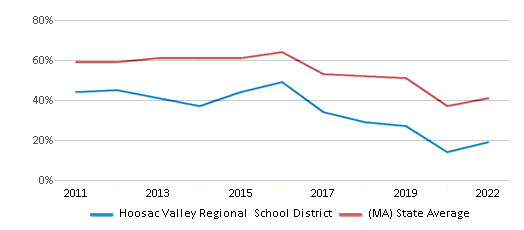
Reading/Language Arts Test Scores (% Proficient)
27%
44%
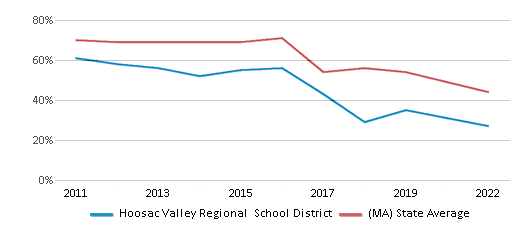
Science Test Scores (% Proficient)
23%
44%

Graduation Rate
85-89%
90%
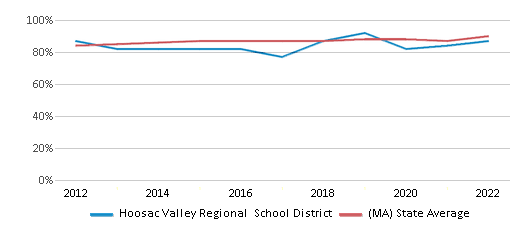
Students by Ethnicity:
Diversity Score
0.24
0.68
# American Indian Students
2 Students
816 Students
% American Indian Students
n/a
n/a
# Asian Students
6 Students
21,318 Students
% Asian Students
1%
7%
# Hispanic Students
52 Students
84,297 Students
% Hispanic Students
5%
28%
# Black Students
32 Students
37,053 Students
% Black Students
3%
12%
# White Students
850 Students
142,107 Students
% White Students
87%
48%
# Hawaiian Students
1 Student
291 Students
% Hawaiian Students
n/a
n/a
# Two or more races Students
35 Students
13,358 Students
% of Two or more races Students
4%
5%
Students by Grade:
# Students in PK Grade:
59
2,713
# Students in K Grade:
73
7,222
# Students in 1st Grade:
76
7,530
# Students in 2nd Grade:
99
7,944
# Students in 3rd Grade:
63
8,002
# Students in 4th Grade:
86
8,676
# Students in 5th Grade:
71
19,802
# Students in 6th Grade:
74
55,437
# Students in 7th Grade:
78
68,011
# Students in 8th Grade:
78
68,221
# Students in 9th Grade:
53
11,995
# Students in 10th Grade:
78
11,729
# Students in 11th Grade:
47
11,460
# Students in 12th Grade:
43
10,610
# Ungraded Students:
-
379
District Revenue and Spending
The revenue/student of $25,905 is higher than the state median of $23,845. The school district revenue/student has grown by 5% over four school years.
The school district's spending/student of $22,736 is less than the state median of $24,602. The school district spending/student has grown by 5% over four school years.
Total Revenue
$25 MM
$21,850 MM

Spending
$22 MM
$22,544 MM
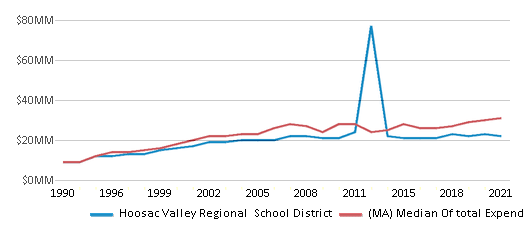
Revenue / Student
$25,905
$23,845

Spending / Student
$22,736
$24,602
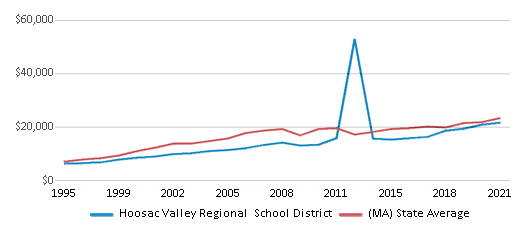
Best Hoosac Valley Regional School District Public Middle Schools (2025)
School
(Math and Reading Proficiency)
(Math and Reading Proficiency)
Location
Grades
Students
Rank: #11.
Hoosac Valley High School
(Math: 20-24% | Reading: 30-34%)
Rank:
Rank:
3/
Bottom 50%10
125 Savoy Rd
Cheshire, MA 01225
(413) 743-5200
Cheshire, MA 01225
(413) 743-5200
Grades: 8-12
| 299 students
Rank: #22.
Hoosac Valley Middle School
(Math: 17% | Reading: 24%)
Rank:
Rank:
2/
Bottom 50%10
125 Savoy Road
Cheshire, MA 01225
(413) 743-8404
Cheshire, MA 01225
(413) 743-8404
Grades: 4-7
| 309 students
Recent Articles

Year-Round Or Traditional Schedule?
Which is more appropriate for your child? A year-round attendance schedule or traditional schedule? We look at the pros and cons.

Why You Should Encourage Your Child to Join a Sports Team
Participating in team sports has a great many benefits for children, there is no doubt. In this article you will learn what those benefits are.

White Students are Now the Minority in U.S. Public Schools
Increasing birth rates among immigrant families from Asia and Central and South America, combined with lower birth rates among white families, means that for the first time in history, public school students in the United States are majority-minority. This shift in demographics poses difficulties for schools as they work to accommodate children of varying language abilities and socio-economic backgrounds.





